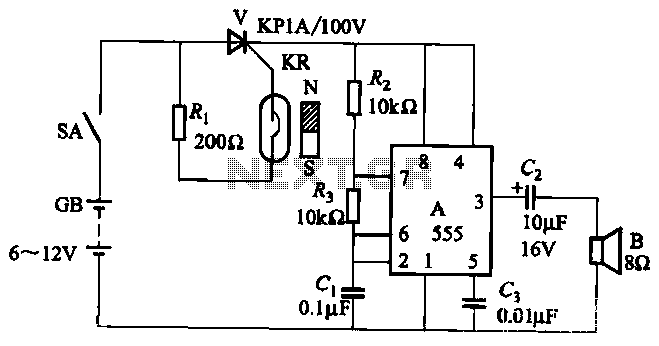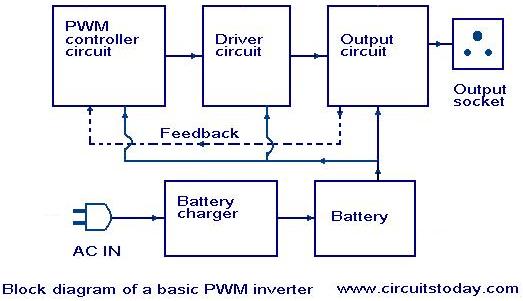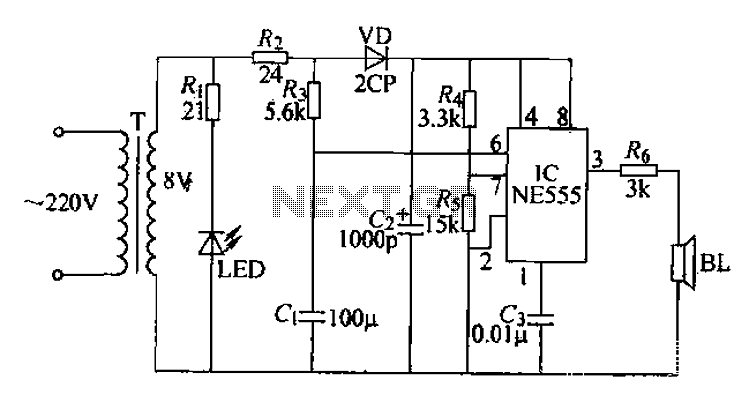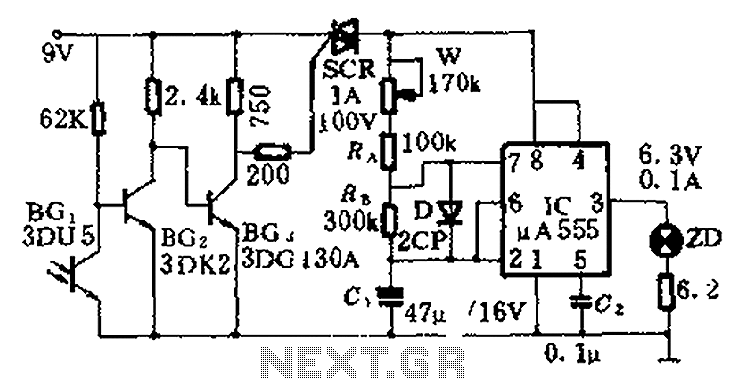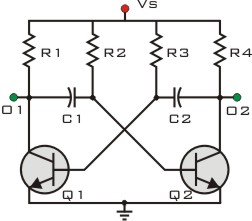
Circuit diagram of an analog circuit PWM
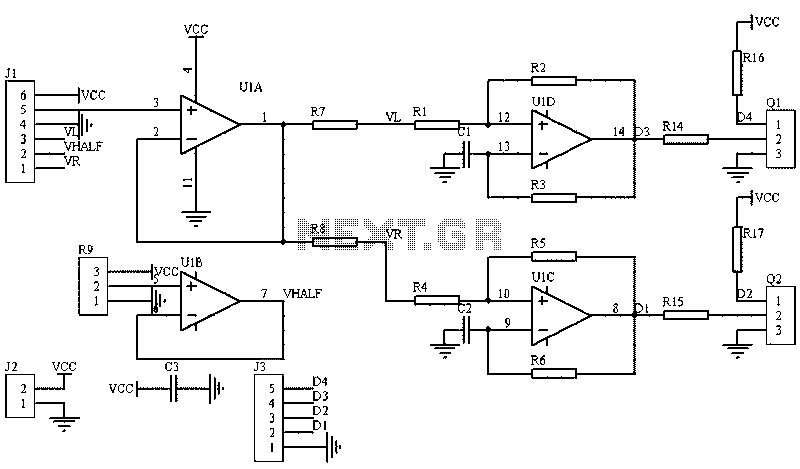
The image illustrates a circuit that utilizes a linear potentiometer (or linear Hall element) to control the PWM generation for two chassis drive motors in a gamepad or joystick used in model aircraft. J1 represents the handle of the potentiometer, which operates in both x and y directions. U1B supplies half of the supply voltage, while U1A functions as a voltage follower. The x and y components from the left and right wheels are synthesized to create two voltage signals that control motor speeds. The equations used for control are L = (x + 1)y / (x + 1.4) and R = (x - 1)y / (x - 0.6), which have been tested with favorable results (in digital units only, not voltage values). U1C and U1D form a Schmitt oscillator that converts the voltage into a corresponding PWM signal for the power driver circuit. In the case of U1D, resistors R1 and R2 create hysteresis for the Schmitt trigger circuit, establishing the upper and lower voltage thresholds. Capacitor C1 and resistor R3 create a delay circuit, thus controlling the oscillation width based on the input voltage. Transistors Q1 and Q2 form an inverter to provide differential control signals. The analysis of the 555 oscillator can be referenced in textbooks that cover specific oscillation digital circuits.
The circuit utilizes a linear potentiometer or Hall effect sensor to generate control signals for the PWM (Pulse Width Modulation) used in driving two motors. The potentiometer is positioned to allow for dual-axis control, enabling precise manipulation of the model aircraft's movement. The circuit's design incorporates operational amplifiers U1A and U1B to manage voltage levels effectively; U1B stabilizes the voltage to half the supply level, which is critical for accurate motor control.
The synthesized signals derived from the potentiometer's x and y readings are mathematically processed to yield the desired motor speed control voltages. The equations employed for this purpose allow for dynamic adjustments based on user input, ensuring that the aircraft responds accurately to joystick movements. The Schmitt oscillator configuration formed by U1C and U1D is essential in translating the varying voltage levels into a stable PWM signal, which is crucial for motor control applications.
Hysteresis, created by resistors R1 and R2, helps to prevent noise from causing erratic behavior in the output signals. This feature is particularly important in environments where electrical noise may interfere with the control signals. The timing components, C1 and R3, work together to define the frequency and duty cycle of the PWM signal, allowing for fine-tuning of the motor speed.
Transistors Q1 and Q2 serve as inverters, ensuring that the control signals are appropriately processed to drive the motors effectively. The circuit design reflects principles found in classic oscillator circuits, such as the 555 timer, emphasizing the importance of stability and reliability in electronic control systems. This configuration is well-suited for applications requiring precise control of motor functions, such as in remote-controlled model aircraft.The picture shows the use of a linear potentiometer (or linear Hall element) control two chassis drive motor PWM generation circuit gamepad or joystick on the model aircraft. J1 is the handle of the socket 123 and 456, respectively potentiometer x, y in both directions. U1B provides half supply voltage, U1A is a voltage follower. x, y component of the left and right wheels via synthetic become two motor speed control voltage signal. In use, let L = (x + 1) y / (x + 1.4), R = (x-1) y / (x-0.6), tested have good results (digital units only, not the voltage value) .
After U1C and U1D Schmitt oscillator consisting of a voltage converted to the corresponding PWM signal for controlling power driver circuit. In Case U1D, R1, R2 have the composition hysteresis Schmitt trigger circuit, that the upper and lower threshold of input voltage, C1 and R3 delay circuit, thus formed by the oscillation width input voltage control.
Q1, Q2 is a transistor, the composition of the inverter provides the control signal difference. Analysis of the oscillator 555 on textbooks refer to the specific oscillation digital circuits.
The circuit utilizes a linear potentiometer or Hall effect sensor to generate control signals for the PWM (Pulse Width Modulation) used in driving two motors. The potentiometer is positioned to allow for dual-axis control, enabling precise manipulation of the model aircraft's movement. The circuit's design incorporates operational amplifiers U1A and U1B to manage voltage levels effectively; U1B stabilizes the voltage to half the supply level, which is critical for accurate motor control.
The synthesized signals derived from the potentiometer's x and y readings are mathematically processed to yield the desired motor speed control voltages. The equations employed for this purpose allow for dynamic adjustments based on user input, ensuring that the aircraft responds accurately to joystick movements. The Schmitt oscillator configuration formed by U1C and U1D is essential in translating the varying voltage levels into a stable PWM signal, which is crucial for motor control applications.
Hysteresis, created by resistors R1 and R2, helps to prevent noise from causing erratic behavior in the output signals. This feature is particularly important in environments where electrical noise may interfere with the control signals. The timing components, C1 and R3, work together to define the frequency and duty cycle of the PWM signal, allowing for fine-tuning of the motor speed.
Transistors Q1 and Q2 serve as inverters, ensuring that the control signals are appropriately processed to drive the motors effectively. The circuit design reflects principles found in classic oscillator circuits, such as the 555 timer, emphasizing the importance of stability and reliability in electronic control systems. This configuration is well-suited for applications requiring precise control of motor functions, such as in remote-controlled model aircraft.The picture shows the use of a linear potentiometer (or linear Hall element) control two chassis drive motor PWM generation circuit gamepad or joystick on the model aircraft. J1 is the handle of the socket 123 and 456, respectively potentiometer x, y in both directions. U1B provides half supply voltage, U1A is a voltage follower. x, y component of the left and right wheels via synthetic become two motor speed control voltage signal. In use, let L = (x + 1) y / (x + 1.4), R = (x-1) y / (x-0.6), tested have good results (digital units only, not the voltage value) .
After U1C and U1D Schmitt oscillator consisting of a voltage converted to the corresponding PWM signal for controlling power driver circuit. In Case U1D, R1, R2 have the composition hysteresis Schmitt trigger circuit, that the upper and lower threshold of input voltage, C1 and R3 delay circuit, thus formed by the oscillation width input voltage control.
Q1, Q2 is a transistor, the composition of the inverter provides the control signal difference. Analysis of the oscillator 555 on textbooks refer to the specific oscillation digital circuits.
Warning: include(partials/cookie-banner.php): Failed to open stream: Permission denied in /var/www/html/nextgr/view-circuit.php on line 713
Warning: include(): Failed opening 'partials/cookie-banner.php' for inclusion (include_path='.:/usr/share/php') in /var/www/html/nextgr/view-circuit.php on line 713
